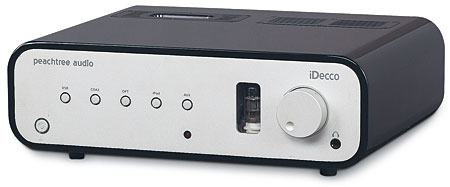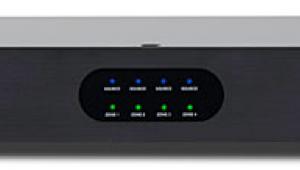Peachtree Audio iDecco Stereo Integrated Amplifier Page 3
CD via Player
When the time came to leave the lossy kingdom, I switched to the iDecco’s coax input and loaded the Rotel CD player with Thelonious Monk’s breakthrough album Brilliant Corners, using the CD layer of the 2004 SACD hybrid disc. Riverside’s 1956 mono recording is actually pretty hi-fi worthy. I can never resist the twinkle of celesta on “Pannonica,” Monk’s tribute to the aristocratic jazz fan who would nurse him in his final years. But what sounded different was the piano. Its overtones became distinctly richer than the leaner treatment I’m used to with my exclusively solid-state amp.

The Knights are not a rock band but a New York–based orchestra conducted by Eric Jacobsen. Their Sony Classical CD New Worlds, featuring cellist Jan Vogler, begins and ends with two 20th-century crowd pleasers: Ives’ The Unanswered Question and Copland’s Appalachian Spring. In between are works by Dvorák and two lesser-known composers. What impressed me about the string sound was how fully developed yet unfatiguing it was. When it needed to bite, it bit, but there were also long stretches of sensuous euphony. The cello benefited even more, taking on a voice-like quality.
To the Rack
It was time to leave the desktop and its Era speakers and move to the main rack, dominated by the Paradigms, the OPPO universal player, and—in this case—Blu-ray Discs with DTS-HD Master Audio soundtracks. The movies’ lossless surround soundtracks were downmixed to two channels and exited the player through its analog outputs. I was glad to be using the Special Edition version of the OPPO, which has upgraded analog circuitry.
Two speakers operated full range with no sub. I value the Paradigms because I find them to be utterly truthful and thus appropriate for reviews of A/V receivers and amps. When I paired them with the iDecco, they offered a candid portrait of the way the latter really sounds: brilliantly organized, lush, sweet, and revealing in a good way, not rolled off or dumbed down.
The Wolfman, with Benicio Del Toro and Anthony Hopkins in tow, knocked me flat. The two-channel soundstage was just huge. Within it was so much texture and layering that my mind raced to keep up with it all. On a visceral level, the iDecco delivered the kind of carnal pleasure that A/V receivers seemingly muster only in the $2,000-and-up category (and even then not consistently). I often moved between the volume knob’s 10 and 11 o’clock positions to balance dialogue with effects—but remember, I was listening with no center speaker and relied on the player to handle the downmix to two channels.
The Edge of Love is a World War II story about the tangled love lives of two couples, including a fictionalized Dylan Thomas. The story is told from the viewpoint of the Keira Knightley character (her mother, Sharman Macdonald, wrote the script). The highlights were Matthew Rhys’ Welsh-accented voiceover readings of Thomas’ verses, playing against war visuals. The story’s backdrop is the blitz, so sirens often hovered in the background. They sounded as though they were emanating more from around the speakers than from within them, yet they were disturbingly evocative, like a lurking physical threat. There was also what my notes refer to as a “bomb!” The iDecco did pretty well with sudden low-frequency content, with more impact than many low- to moderate-priced AVRs.
Peachtree Audio’s iDecco is a killer desktop amp, especially when fed through its jitter-controlled, enhanced-DAC-equipped digital inputs. Here’s a product that bridges the yawning gap between the hi-fi verities and the way many music lovers listen now. But I’m afraid you won’t be able to read my last few words about Peachtree’s killer amps. They’ll be written in my checkbook.

- Log in or register to post comments





























































